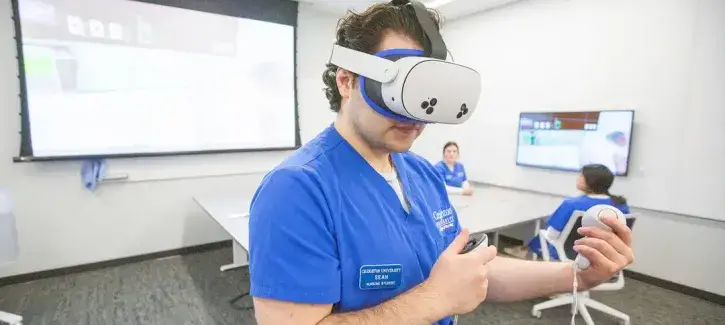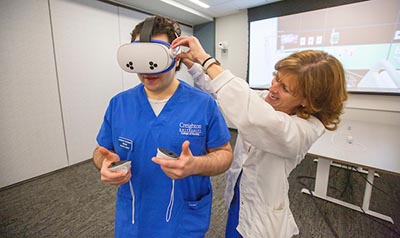
Advancing nursing education through immersive virtual reality simulations

Sarah Ball, PhD, RN, has always been passionate about enhancing simulation education for nursing students, with their well-being and success at the forefront.
Ball’s passion for simulation began during her master’s program at Walden University, where she helped CHI launch its first high-fidelity OB simulator and researched how simulations reduce nurse anxiety.
As a faculty member at Creighton University, her creativity and curiosity thrived, leading her to develop augmented reality 360-degree photo spheres for her PhD study with help from Creighton’s IT team. These virtual tours familiarized students with OB hospital units before clinicals, significantly lowering anxiety and increasing satisfaction—ultimately enhancing their ability to learn and succeed in real-world settings.
This success ignited Ball’s interest in expanding interactive virtual reality (VR) learning beyond traditional manikin-based simulations. VR tools, like Meta Oculus Headsets, sponsored by an anonymous donor, immerse students in realistic clinical environments where they interact with patients, take vital signs, start IVs and even engage in dynamic, AI-driven conversations that mimic real-world nurse-patient interactions.
“In virtual reality simulations, we’re really able to teach students about clinical judgement while integrating therapeutic practice, professional communication and skills nurses need,” says Ball. “The fun part about AI is that what you say results in a different patient reaction, just like in real life.”
Recognizing the potential of VR for student preparedness, Ball formed her next question: Can student performance be evaluated in virtual reality just as effectively as in traditional simulation settings?
Creighton’s Competency Evaluation Instrument (C-CEI), an innovative assessment tool, has been proven to accurately evaluate learning objectives and outcomes in traditional simulations. Ball joined the C-CEI 2.0 research team, led by Martha Todd, PhD, APRN-NP, and Julie Manz, PhD, RN, to test its reliability in immersive VR simulations.

The study started in fall 2024 with junior-year nurses in a post-partum hemorrhage scenario. In real-time, faculty watched and evaluated students in the VR simulation from two different screens. “And as we completed the statistical analysis and comparison of the faculty, we found there is reliability of the C-CEI 2.0 when we use it for immersive virtual reality as a tool to evaluate.”
Beyond assessment reliability, the study highlighted additional benefits of VR simulation, such as standardization and enhanced student preparedness in simulation evaluation.
The structured four-week study took students through the VR simulation experience. They began by ensuring students were comfortable with the technology and could use it safely, followed by team collaboration as well as individual practice. Ultimately, students demonstrated their clinical judgement and skills for the immersive virtual simulation of the postpartum hemorrhage scenario during the fourth week as a summative evaluation for the clinical rotation.
“We found that because students experienced the same scenarios through VR simulation, there was a level of consistency across experiences the prior week, ensuring all students were on the same page,” says Ball. Additionally, students reported reduced anxiety before their final simulation, feeling more confident and prepared.
“My most significant growth within this simulation was my confidence in performing assessments,” says nursing student Isaiah Tovar. “At the beginning of the rotation, I was unsure of myself. However, by the end of the rotation, I understood the medications and their therapeutic uses, procedures and assessments to perform on our patients.”
VR simulations also allow students to revisit their work, identify areas for improvement and collaborate with peers locally and remotely, including those on Creighton’s Phoenix campus. “With VR, we have an opportunity to make mistakes and improve without the repercussions of a real patient. The greatest growth I saw from myself was how I was open and able to repeat the same skill for mastery,” says nursing student Zoey Lundin.
The impact of immersive VR simulations is extending beyond clinical training into the classroom in the College of Nursing, with Ball’s med-surg partner, Christine Young, MS, RN, introducing VR for a skin assessment and a fall safety assessment during the 2024-2025 academic year. By casting the VR simulation onto a screen, instructors and students could participate, give instruction and engage in real-time discussions, “making learning more interactive and collaborative,” says Ball.
In addition, the mental health team is working with a partner to develop an AI-powered application for VR simulation training, while Ball and paramedicine faculty Ryan Batenhorst, EdD, NRP, have secured a grant for free headsets and a three-month trial of a body-swap communication application.
Using body-swap, students can watch their recording and pick up on their verbal and nonverbal communication cues, providing powerful insights into becoming more empathetic and compassionate providers. “It’s a powerful tool for practicing professional therapeutic communication, handoffs, giving reports, patient interviews and de-escalations as well as overall leadership,” Ball says, adding that this application will be a focus for her in fall 2025.
Next spring, Ball will explore the integration of Objective Structured Clinical Examinations (OSCEs) with traditional high-fidelity manikin simulations and VR simulations in the senior capstone preceptorship. OSCEs ensure that students are practice-ready, achieving a 100% competency rate in the behaviors clinical partners expect—including clinical judgment, communication, knowledge and technical skills. However, delivering this level of training places a significant workload on nursing faculty, who must constantly reset and prepare simulation rooms. By incorporating VR technology, Ball aims to streamline the process and reduce faculty burden. She is currently collaborating with a company in trial phases, which has expressed interest in offering Creighton credit for its contributions. The ultimate goal is to enhance student competency while optimizing faculty resources.
As Ball continues to explore her passion for simulation and application of VR, she’s maintained her student-centered focus: “I'm elated to follow the success in VR simulation and continue to form the next generation of Creighton nurses through this technology,” she concludes.




